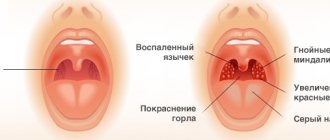Staphylococcal tonsillitis is one of the most common types of bacterial tonsillitis.
Sore throat (acute tonsillitis) is an infectious disease characterized by damage to the palatine tonsils. In most cases, the cause of sore throat is viruses.
But with weakened immunity or with high activity of bacterial infection, the main source of inflammation is the microbial flora.
According to statistics, about 2% of people visit a doctor at least once a year for a sore throat. In most cases these are school-age children.
The number of visits to the doctor increases noticeably in the autumn-winter period. If tonsillitis is of viral origin, then special treatment is usually not required.
But with bacterial tonsillitis, complex drug therapy is necessary, which should protect the patient from possible complications.
Staphylococcal sore throat: causes
Normally, staphylococci belong to a conditionally pathogenic environment, i.e., in a normal state of immunity, this type of microflora does not cause harm.
A huge number of bacteria every second try to enter the human body through the nose and mouth, but the tonsils and other components of the lymphoepithelial ring successfully retain and destroy microbes.
A large number of white blood cells, which are the main component of the immune system, circulate in the tonsils.
During the fight against pathogenic flora, white blood cells begin to release inflammatory cytokines, which lead to swelling, fever and redness of the tonsils.
Staphylococcal tonsillitis is not as common as, for example, viral or streptococcal tonsillitis, but the disease is characterized by a severe course and a high incidence of complications.
Why is it important
First of all, any treatment will be ineffective without microbiological analysis, which can only be carried out in a clinic. It is he who determines the causative agent of pathology in the throat. Of course, you can remove the unpleasant symptoms of a sore throat yourself with the help of high doses of antibiotics. But now, it will not be possible to completely cure the disease; the sore throat will subside, and then remind itself, degenerating into dangerous endocarditis or rheumatism.
Among other things, Staphylococcus aureus, which can cause a sore throat, is not always treatable with strong modern antibiotics. This bacterium also mutates. Therefore, independent attempts to get rid of this infection can result in toxic shock.
The doctor, unlike self-medication, will heal a patient with a sore throat faster and more efficiently - he has not only extensive experience, but also rich diagnostic functionality.
Whatever one may say, sore throat is treated with antibiotics. True, which ones exactly are determined only by the results of special tests that will indicate the causative agent of the infection. Also, in the acute period of the disease, it is necessary to take antipyretic drugs - when infected with staphylococcus, an increase in temperature occurs quite often and it quite aggravates the general condition of the patient.
Symptoms
Symptoms of the development of staphylococcal sore throat can be divided into common and rare.
Typical symptoms for acute tonsillitis are:
- a sore throat,
- swelling of the tonsils,
- high body temperature,
- headache,
- general malaise,
- white spots on tonsils,
- enlarged lymph nodes in the neck,
- pain in the ears or neck,
- weight loss,
- difficulty swallowing food, liquids,
- sleep disturbance.
Symptoms and signs
In adults
- Fever caused by a sudden increase in temperature.
- Swallowing is complicated by sore throat.
- Difficulty in breathing.
- Dirty white coating on the tonsils.
- Severe weakness.
- Intoxication.
- Inflammation of the peripharyngeal tissues.
- Swelling of the mucous membranes.
- Touching the lymph nodes is painful, and their enlargement is observed.
- Possible cough.
- Muscle pain.
- Formation of ulcers on the tonsils.
The acute stage lasts no more than a week, but in the absence of proper therapy it can drag on and be aggravated by a number of complications.
How to distinguish tonsillitis of different etiologies:
In children
Symptoms of staphylococcal tonsillitis in children often appear against the background of acute respiratory viral infections or during exacerbations of untreated ENT diseases. In addition to the general symptoms, the following may be added:
- Intestinal disorders.
- Allergic rash.
- Conjunctivitis.
- Convulsions due to fever.
- Loss of consciousness, delirium.
- Vomit.
Diagnostics
Staphylococcal tonsillitis is diagnosed based on a bacterial examination of a throat smear.
The contents of the smear are applied to a nutrient medium, on which the bacterial culture will multiply over several days.
To make a correct diagnosis, a general blood test with a characteristic increase in the number of white blood cells and a shift in the leukocyte formula to the left is also important.
How and with what to treat staphylococcal sore throat
Treatment of tonsillitis caused by Staphylococcus aureus is long and complex. The selection of the necessary antibiotic is carried out only after special laboratory diagnostics, since this type of bacteria is resistant to many drugs.
Treatment is not limited to taking antibacterial drugs; therapy includes a set of measures aimed at preventing complications. It is mandatory to disinfect the premises where the patient was.
How is staphylococcal sore throat treated:
- Antibiotics - most often this is a group of cephalosporins or macrolides.
- Antipyretics - containing paracetamol.
- Diuretics - Furosemide (for severe swelling).
- Antiseptic solutions for gargling - Furacilin, Chlorophyllipt.
- Immunostimulants - Faringosept, Strepsils, Septolete.
- Vitamin and mineral complexes in tablets.
Treatment for infection with Staphylococcus aureus is to increase the body's resistance, so it is necessary to change the diet. The patient is advised to eat more vitamin and protein foods, drink plenty of fluids, and avoid heavy foods.
At home, you can use folk remedies, but they are considered only as an auxiliary measure. These can be herbal decoctions for gargling, tinctures for oral administration to improve well-being.
To gargle, you can use potato decoction, beet juice, chamomile, and sage decoctions. To relieve a sore throat, you can eat frozen foods. But it is better to check the benefits of this with your doctor, since the opinions of specialists on this topic differ.
Symptoms of severe intoxication are relieved by drinking plenty of fluids and taking symptomatic medications, depending on the manifestations and signs. To improve the condition, the patient is prescribed bed rest, rest, should not be exposed to stress, and is recommended to give up alcohol and cigarettes.
During pregnancy, if sore throat occurs relatively often, the main treatment is to take antibiotics approved during pregnancy. Only a doctor can prescribe them; self-medication is prohibited.
Antibiotics for children, as well as during pregnancy, are selected from those drugs that cause a minimum of adverse reactions during the course.
Staphylococcal tonsillitis: treatment
There are several approaches to treating a patient with staphylococcal tonsillitis. Symptomatic treatment is aimed at eliminating the main clinical manifestations of the disease.
In the fight against symptoms such as pain, redness of the tonsils, and fever, non-steroidal anti-inflammatory drugs (ibuprofen, paracetamol) help well.
Staphylococcal tonsillitis requires the use of antibacterial drugs. Against staphylococcal infections, the priority is the use of penicillins or amoxicillin.
Cephalosporins and macrolides are a good alternative to penicillin in patients with high severity of the inflammatory process.
In addition, macrolides such as erythromycin and clarithromycin are indicated for patients allergic to penicillin.
If the above-described bacterial therapy is ineffective, patients are transferred to antibiotics from the beta-lactam group (clindamycin, amoxicillin-clavulanate).
For chronic tonsillitis, which significantly worsens the quality of life, surgical treatment is a priority.
Causes of the disease
- Chronic or seasonal weakening of immunity.
- Infection from a carrier of staphylococcal infection (occurs by airborne droplets).
Kinds
Streptococcal forms of sore throat are most often diagnosed, but Staphylococcus aureus can also cause the following types of disease:
- Catarrhal (initial stage of bacterial infection without ulcers).
- Follicular (characterized by a more acute onset of development and the presence of ulcers on the tonsils).
- Lacunar (abscesses on the tonsils, merging with each other, form a mesh pattern).
- Ulcerative-necrotic (damage to deeper tissues with their subsequent necrosis).
The photo shows types of sore throat caused by staphylococcal infection
Complications
Staphylococcal tonsillitis is characterized by a high incidence of complications and the difficulty of their treatment. Often this type of infection requires the use of surgical procedures.
The most common complication is peritonsillar abscess. Normally, the palatine tonsils are surrounded by fatty tissue.
When bacterial flora enters this area, it begins to actively multiply. The body’s protective reaction in this case is the formation of a fibrous capsule surrounding the purulent focus.
Such a capsule is called an abscess, and if it is not opened or punctured in time, this can lead to sepsis or the spread of infection to other organ structures.
A rarer, but also more severe complication is mediastinitis.
With retropharyngeal spread of infection, damage to the fatty tissue of the mediastinum surrounding the chest organs may develop.
This complication is characterized by a high mortality rate and difficult to treat, so at the first signs of mediastinitis, antibiotics should be prescribed immediately.
Possible complications, why the disease is dangerous
The danger of sore throat of staphylococcal etiology is that it can cause a number of serious complications. The heart, joints and kidneys are primarily at risk. Against the background of an advanced or untreated disease, the following pathologies may occur:
- Asphyxia.
- Pericarditis.
- Heart disease.
- Staphylococcal myocarditis.
- Blood poisoning.
- Pneumonia.
- Otitis.
- Pleurisy.
For information about complications after a sore throat, watch our video:
Staphylococcal tonsillitis: prevention
Specific prophylaxis to help prevent the development of angina has not been developed at the moment.
All measures to prevent the occurrence of the disease come down to strengthening the immune system and preventing contact with carriers of infection.
General recommendations include:
- maintaining high physical activity,
- cold and hot shower,
- avoiding overwork,
- quitting smoking and drinking alcoholic beverages,
- preventing contact with sick people.
Treatment
Treatment of an infection caused by Staphylococcus aureus consists of destroying the cause, and symptomatic treatment is also used. There are:
Antibiotic therapy. Immunotherapy. Local treatment.
After determining the pathogen group, the selection of the necessary antibiotic begins. This stage is the main thing in the treatment process! Not every antibacterial agent can get rid of staphylococcus, and besides, modern drugs are often ineffective. The bacterium is capable of mutating.
To determine the drug that can help you with treatment, it is necessary to conduct a bacteriological culture for sensitivity. That is, an antibiotic is determined that is suitable specifically for your case.
Treatment must be carried out under the supervision of a doctor, since taking regular tests allows you not to miss the moment when staphylococcus begins to adapt to the chosen therapy.
Symptomatic treatment consists of taking antipyretics, prescribing special throat sprays, tablets and lozenges. Immunomodulators that increase immunity and help the body fight the disease will be effective. Do not ignore local antiseptics.
Sometimes a special virus is used to treat staphylococcal sore throat, which has a detrimental effect on resistant Staphylococcus aureus cells.
The duration of treatment depends on the severity of the disease and the effectiveness of the prescribed course. However, it is worth paying attention that the symptoms disappear much earlier than the pathogen itself dies.
Do not ignore treatment, as if the disease becomes chronic, it will be much more difficult to cope with the problem. At the site of the plaque, adhesions and scar changes form.
Treatment of untreated staphylococcal sore throat lasts 7-10 days. At this time, you should not strain your throat, avoid cold and hot drinks, and, if possible, complete rest.
Of course, it is better to take care of preventing the disease: lead a healthy lifestyle, exclude possible contact with sick people, exercise and eat right, but if you cannot avoid the disease, take all measures to stop the symptoms and begin to effectively fight the insidious virus.











